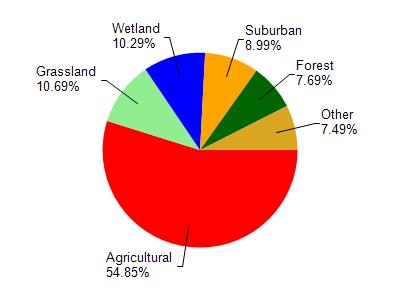Dane
No
No
Yes
Fish and Aquatic Life
Overview
This small ditched stream joins Door Creek south of U.S. Hwy 12/18. It begins in the south central portion of the Town of Cottage Grove. The creek has a surface acreage of 2.3 acres, gradient of 11.8 feet/mile and a baseflow of 1.8cfs. Agricultural lands dominate the watershed and several small areas of wet meadow adjoin the stream along its length. Water quality is below average due to intensive agricultural influences including hydrologic modification and non-point source pollution. Low flow, turbidity and ditching limit the fishery to forage species. Commonly found fish species include the brassy minnow, creek chub, white sucker, brook stickleback, and johnny darter. Improved soil conservation practices in the watershed are needed to improve the fishery and water quality
Date 2002
Author Aquatic Biologist
Historical Description
Little Door Creek -T7N, R11E, Sec. 32, Surface acres = 2.5, Length = 3 miles, Stream order = I, Gradient = 11.8 ft/mile,
Base discharge = 1.8 cfs.
This small, ditched stream joins Door Creek north of Hwy. 1-90. Agricultural lands dominate the watershed and several small areas of fresh meadow adjoin the stream along its length. Water quality below average due to intensive agricultural influences. Low flow and ditching limit the fishery to forage species. Improved soil conservation practices in the watershed are needed to improve the fishery and water quality. Four road crossings provide access.
Fish species: brassy minnow, creek chub, white sucker, brook stickleback, and Johnny darter.
From: Day Elizabeth A.; Grzebieniak, Gayle P.; Osterby, Kurt M.; and Brynildson, Clifford L., 1985. Lake and Stream Classification Project. Surface Water Resources of Dane County, Wisconsin Department of Natural Resources, Madison, WI
Date 1985
Author Surface Water Inventory Of Wisconsin
Impaired Waters
The 2018 assessments of Little Door Creek showed impairment by phosphorus; new total phosphorus sample data exceeded the 2018 WisCALM listing criteria for the Fish and Aquatic Life use. However, no biological data (i.e. no macroinvertebrate or fish Index of Biotic Integrity (IBI) scores) were available to assess biological impairment. Based on the most updated information, this water was proposed for the impaired waters list.
Date 2017
Author Ashley Beranek
Condition
Wisconsin has over 84,000 miles of streams, 15,000 lakes and milllions of acres of wetlands. Assessing the condition of this vast amount of water is challenging. The state's water monitoring program uses a media-based, cross-program approach to analyze water condition. An updated monitoring strategy (2015-2020) is now available. Compliance with Clean Water Act fishable, swimmable standards are located in the Executive Summary of Water Condition in 2018. See also the 'monitoring and projects' tab.
Reports
Management Goals
Wisconsin's Water Quality Standards provide qualitative and quantitative goals for waters that are protective of Fishable, Swimmable conditions [Learn more]. Waters that do not meet water quality standards are considered impaired and restoration actions are planned and carried out until the water is once again fishable and swimmable
Management goals can include creation or implementation of a Total Maximum Daily Load analysis, a Nine Key Element Plan, or other restoration work, education and outreach and more. If specific recommendations exist for this water, they will be displayed below online.
Monitoring
Monitoring the condition of a river, stream, or lake includes gathering physical, chemical, biological, and habitat data. Comprehensive studies often gather all these parameters in great detail, while lighter assessment events will involve sampling physical, chemical and biological data such as macroinvertebrates. Aquatic macroinvertebrates and fish communities integrate watershed or catchment condition, providing great insight into overall ecosystem health. Chemical and habitat parameters tell researchers more about human induced problems including contaminated runoff, point source dischargers, or habitat issues that foster or limit the potential of aquatic communities to thrive in a given area. Wisconsin's Water Monitoring Strategy was recenty updated.
Grants and Management Projects
| Project Name (Click for Details) | Year Started |
|---|
|
|
Monitoring Projects
| WBIC | Official Waterbody Name | Station ID | Station Name | Earliest Fieldwork Date | Latest Fieldwork Date | View Station | View Data |
|---|
| 802900 | Little Door Creek | 10043699 | Little Door Creek at Vilas Rd | 5/14/2015 | 5/14/2015 | Map | Data |
| 802900 | Little Door Creek | 10043360 | Little Door Creek at Navig Rd | 1/1/2015 | 10/22/2025 | Map | Data |
| 802900 | Little Door Creek | 133503 | Little Door Creek - Near Cottage Grove WI | 5/25/2001 | 10/18/2001 | Map | Data |
| 802900 | Little Door Creek | 10048219 | Little Door Creek US North Star Rd | 6/18/2018 | 9/21/2025 | Map | Data |
| 802900 | Little Door Creek | 10010957 | Little Door Creek At Cth N | | | Map | Data |
|

Watershed Characteristics
Little Door Creek is located in the Yahara River and Lake Kegonsa watershed which is 126.33 mi². Land use in the watershed is primarily agricultural (54.90%), grassland (10.70%) and a mix of wetland (10.30%) and other uses (24.20%). This watershed has 145.73 stream miles, 3,600.04 lake acres and 6,832.19 wetland acres.
Nonpoint Source Characteristics
This watershed is ranked Medium for runoff impacts on streams, Low for runoff impacts on lakes and High for runoff impacts on groundwater and therefore has an overall rank of High. This value can be used in ranking the watershed or individual waterbodies for grant funding under state and county programs.However, all waters are affected by diffuse pollutant sources regardless of initial water quality. Applications for specific runoff projects under state or county grant programs may be pursued. For more information, go to surface water program grants.